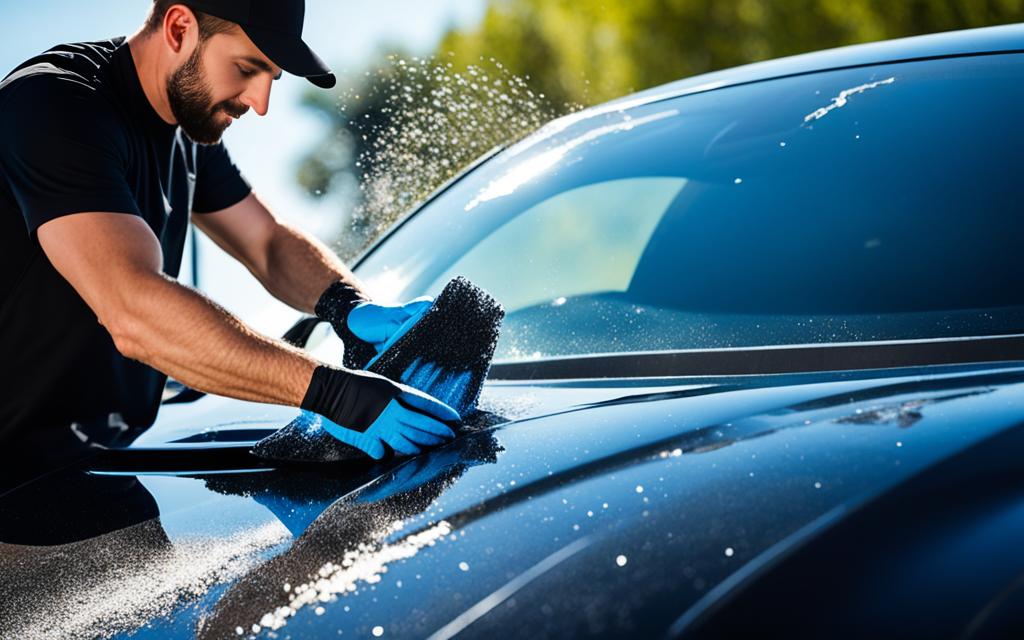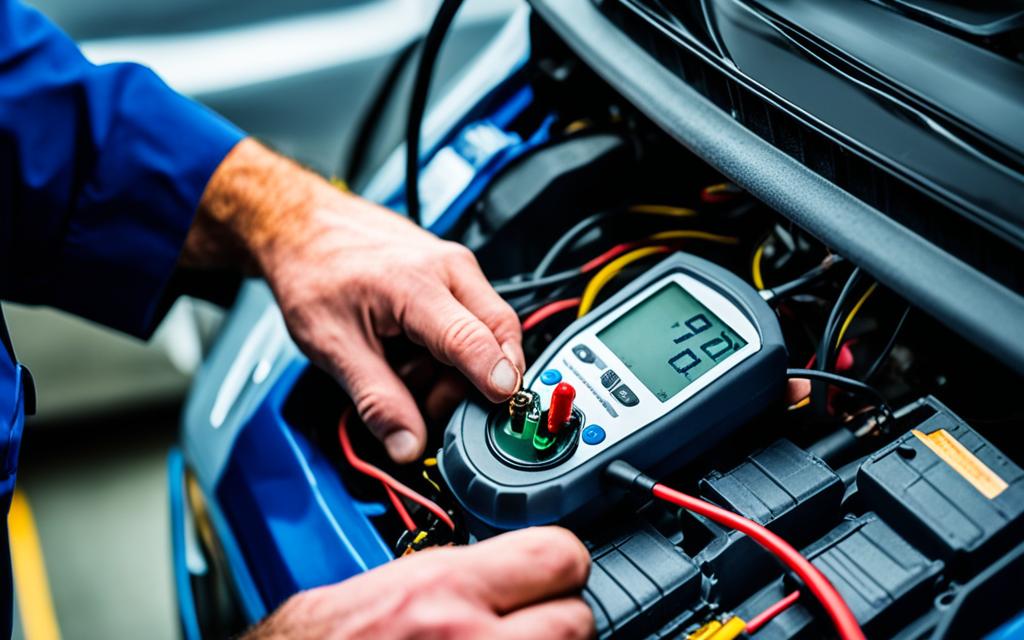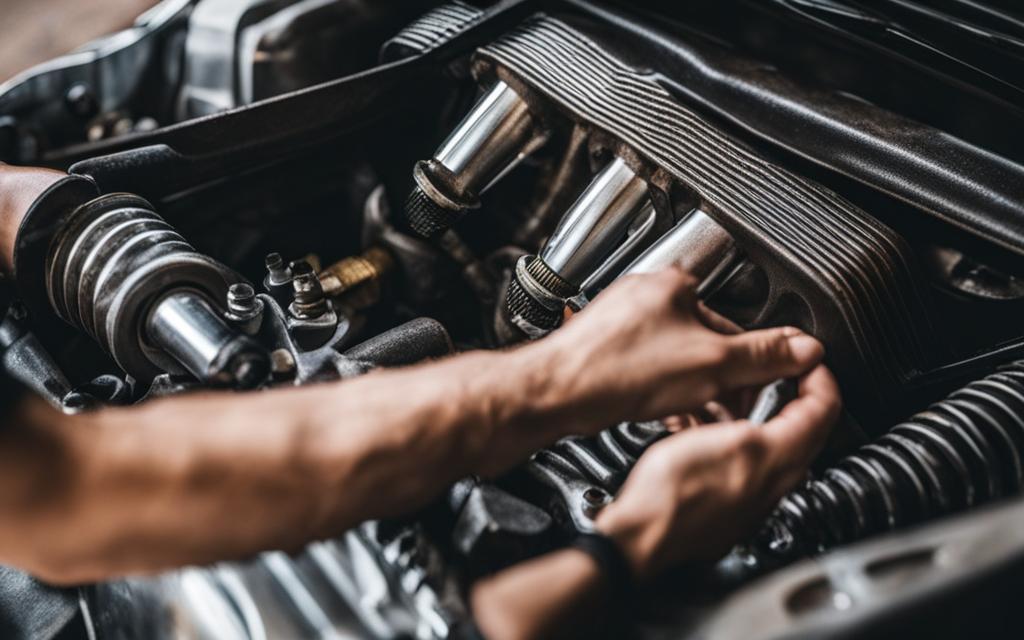Proper maintenance is essential to keep your prestigious vehicle in prime condition. By following elite maintenance tips, you can extend the life of your vehicle and ensure it runs smoothly and reliably. In this article, I will provide you with expert advice and recommendations for car maintenance. From regular car care to engine maintenance, exterior car care, transmission and brake upkeep, interior detailing, wheel and tire maintenance, electric system checks, advanced fluid management, DIY car maintenance, choosing professional auto service, and more, you’ll find comprehensive tips to maximize the performance and longevity of your vehicle. Let’s dive into the details of each section and unlock the secrets to keeping your prestigious vehicle in top shape.
Key Takeaways:
- Regular car maintenance is crucial for extending the life of your vehicle and ensuring safety on the road.
- Proactive practices such as adhering to maintenance schedules and checking fluid levels can prevent major issues and costly repairs.
- Neglecting car maintenance can lead to decreased fuel efficiency, engine problems, brake failures, and other safety concerns.
- At-home exterior car care, including DIY car wash, claybar treatment, and choosing the right car wax, can help keep your vehicle’s exterior in pristine condition.
- Engine maintenance essentials, such as spotting signs of distress and regular oil changes, are vital for engine longevity.
The Importance of Regular Car Maintenance
Regular car maintenance is crucial for several reasons. It helps extend the life of your vehicle, improves overall performance, ensures safety on the road, and enhances resale value.
By following proactive practices such as adhering to maintenance schedules, checking fluid levels, inspecting tires, and performing regular tune-ups, you can prevent major issues and costly repairs.
Neglecting car maintenance can have adverse effects on vehicle performance, leading to decreased fuel efficiency, engine problems, brake failures, and other safety concerns.
By understanding the impact of neglect, you can prioritize regular car maintenance to keep your vehicle in optimal condition.
Achieving a Showroom Shine: At-Home Exterior Car Care
Maintaining a showroom shine on your vehicle’s exterior is an important aspect of car care. By following a regular routine of at-home car care, you can keep your vehicle looking pristine and protect its paint for years to come. In this section, we will discuss essential supplies for a DIY car wash, the benefits of claybar treatment for maintaining pristine paint, and how to choose the right car wax for lasting protection.
Essential Supplies for a DIY Wash
To achieve a thorough and effective DIY car wash, you will need the following supplies:
- A bucket
- Car shampoo
- Microfiber towels
- A hosepipe
These supplies will enable you to safely and efficiently clean your vehicle’s exterior, removing dirt and grime without damaging the paint surface.
Claybar Treatment for Pristine Paint
In addition to regular car washing, it is recommended to perform a claybar treatment every six months to maintain the pristine condition of your vehicle’s paint. Claybar treatment helps remove embedded contaminants that cannot be removed through regular washing alone. By using a claybar, you can achieve a smooth and clean surface, enhancing the overall appearance of your vehicle.
Choosing the Right Car Wax for Lasting Protection
After washing and claybar treatment, it is important to protect your vehicle’s paint with a high-quality car wax. The right car wax will provide lasting protection against various environmental elements, such as UV rays, acid rain, and pollution. When choosing a car wax, consider factors such as durability, ease of application, and the level of protection it offers. Look for reputable brands and read reviews to make an informed decision.
By following these tips and using the right products, you can achieve a showroom shine for your vehicle’s exterior and maintain its pristine paint for years to come. Take pride in your at-home car care routine, and enjoy the benefits of a well-maintained and visually appealing vehicle.

Getting Under the Hood: Engine Maintenance Essentials
Maintaining your vehicle’s engine is crucial for its longevity and performance. Proper engine care not only prevents major issues but also ensures a smooth and reliable driving experience. In this section, we will explore two key aspects of engine maintenance: spotting signs of engine distress and the importance of regular oil changes.
Spotting Signs of Engine Distress
It’s important to be vigilant and recognize the early warning signs of engine problems. By spotting these signs early, you can address them promptly and prevent further damage. Some common signs of engine distress include:
- Strange noises, such as knocking, ticking, or grinding sounds
- Excessive exhaust smoke, indicating potential issues with the fuel or oil
- Decreased power or acceleration
- Warning lights on the dashboard, such as the check engine light
If you notice any of these signs, it’s recommended to consult a qualified mechanic for a thorough diagnosis and appropriate repairs. Ignoring engine distress can lead to more severe problems and costly repairs down the line.
How Regular Oil Changes Keep Your Engine Young
One of the most important engine maintenance tasks is regular oil changes. Engine oil plays a crucial role in lubricating the engine’s moving parts and reducing friction, heat, and wear. Over time, oil breaks down and becomes less effective, which can lead to increased engine wear and decreased performance.
Regular oil changes remove old, contaminated oil and replace it with fresh oil, ensuring optimal lubrication. This helps maintain engine performance, improve fuel efficiency, and extend the overall longevity of your engine. It’s recommended to follow the manufacturer’s guidelines for oil change intervals and use the recommended oil type for your specific vehicle.
By prioritizing regular oil changes as part of your engine maintenance routine, you can keep your engine young and protect it from unnecessary wear and tear.
Car Maintenance Tips: Keeping Your Prestige in its Prime
Prestige vehicles require special attention when it comes to maintenance. To ensure your luxury vehicle remains in prime condition, follow these specific tips and recommendations. By implementing regular maintenance routines and specialized care techniques, you can preserve the prestige and enhance the overall performance of your high-end car.

Maximize Performance: Transmission and Brake Upkeep
Significance of Transmission Fluid Replacement
Proper transmission maintenance is vital for maintaining the performance and longevity of your vehicle. One crucial aspect of transmission care is regular fluid replacement. Transmission fluid plays a crucial role in lubricating the components and regulating temperatures within the transmission system. Over time, the fluid can break down due to heat, friction, and contaminants, leading to diminished performance and potential damage to the transmission.
To ensure optimal transmission performance, it is recommended to follow the manufacturer’s guidelines for fluid replacement. Typically, transmission fluid should be replaced every 30,000 to 60,000 miles or as specified in your vehicle’s owner manual. By adhering to these maintenance schedules and using the appropriate type of transmission fluid, you can prevent premature wear, improve shifting performance, and extend the lifespan of your transmission.
Brake Inspection and Maintenance Schedules
The braking system is crucial for your safety and the safety of others on the road. Therefore, regular brake inspection and maintenance are essential to ensure optimal performance. Inspecting your brakes periodically helps identify potential issues and address them before they escalate into more significant problems.
It is recommended to follow the manufacturer’s maintenance schedules for brake checks and adjustments. Common maintenance intervals include inspecting brake pads and rotors every 12,000 to 15,000 miles or as specified in your vehicle’s owner manual. Routine brake inspections allow you to identify worn-out brake pads, damaged rotors, or any other abnormalities that may affect braking performance.
Maintaining other brake components, such as brake fluid, calipers, and lines, is also crucial for optimal performance. Brake fluid should be checked regularly and replaced as recommended by the manufacturer. By following the recommended brake maintenance schedules and promptly addressing any issues, you can ensure your brakes operate smoothly and safely.
Interior Detailing: Preserving the Elegance Inside
The interior of your vehicle plays a significant role in its overall aesthetics and comfort. Proper interior detailing is essential to preserve the elegance inside. This section will provide you with effective techniques for upholstery care, including cleaning tips and recommendations for maintaining the beauty of your car’s interior. Additionally, you’ll learn how to protect your dashboard from wear and sun damage, enhancing the longevity and appeal of your vehicle’s interior.
Effective Techniques for Upholstery Care
Keeping your car’s upholstery clean and well-maintained not only enhances the visual appeal but also helps preserve its durability. Here are some tips for effective upholstery care:
- Vacuum the seats and floors regularly to remove dust, dirt, and debris.
- Use a soft brush or microfiber cloth to gently clean stains and spills.
- For stubborn stains, consider using specialized upholstery cleaners or seeking professional help.
- Avoid using harsh chemicals or abrasive materials that may damage the fabric.
By following these upholstery care tips, you can keep your car’s interior looking fresh and well-maintained.
Dashboard Protection from Wear and Sun Damage
The dashboard is one of the most visible and vulnerable areas of your car’s interior. Sun exposure and regular use can lead to fading, cracking, and other forms of wear. Here are some ways to protect your dashboard from such damage:
- Use a dashboard cover or sunshade to shield the dashboard from direct sunlight.
- Regularly clean the dashboard with a mild cleaner and soft cloth to remove dust and grime.
- Apply a dashboard protectant or conditioner to keep the surface moisturized and prevent cracking.
- Avoid using abrasive materials or cleaners that can scratch or damage the dashboard.
By taking these dashboard protection measures, you can maintain the elegance and functionality of your car’s interior.
| Interior Care Tips | Sun Damage Protection | Car Interior Detailing |
|---|---|---|
| Regular vacuuming and cleaning | Use a dashboard cover or sunshade | Effective techniques for upholstery care |
| Gentle cleaning of stains and spills | Regularly clean the dashboard | Protecting the dashboard from wear |
| Specialized upholstery cleaners for stubborn stains | Apply a dashboard protectant or conditioner | Avoiding abrasive materials or cleaners |
Wheel and Tire Maintenance for Smooth Rides
Proper wheel and tire maintenance are essential for a smooth and safe driving experience. By taking care of your wheels and tires, you can ensure optimal performance and longevity, as well as enhance the overall appearance of your vehicle.
Regular Tire Rotation and Balancing Explained
One of the key aspects of wheel and tire maintenance is regular tire rotation and balancing. This process involves moving each tire to a different position on the vehicle to ensure even wear. By rotating your tires regularly, you can extend their lifespan and improve overall traction and handling on the road.
To achieve maximum benefits, it is recommended to rotate your tires every 5,000 to 7,500 miles or as specified in your vehicle’s owner’s manual. This can vary depending on the type of tire, vehicle, and driving conditions.
Keeping Your Wheels Immaculate with the Right Cleaners
In addition to rotation and balancing, keeping your wheels clean is essential for both aesthetic and functional reasons. Clean wheels not only enhance the appearance of your vehicle but also prevent damage caused by dirt, brake dust, and road grime.
When cleaning your wheels, it’s important to use the right cleaners that are specifically designed for your wheel type and finish. For example, alloy wheels may require different cleaners than chrome or painted wheels. Be sure to follow the manufacturer’s instructions and use gentle brushes or sponges to avoid scratching or damaging the wheels.

Tire Care and Smooth Rides
Proper tire care is crucial for a smooth and comfortable ride. Here are a few additional tips:
- Check tire pressure regularly and maintain it at the recommended level. Underinflated or overinflated tires can affect performance and fuel efficiency.
- Inspect tires for signs of wear, such as tread depth and any visible damage. Replace tires that are worn out or have significant damage to ensure safety on the road.
- Monitor wheel alignment and have it corrected if necessary. Proper alignment helps prevent uneven tire wear and improves handling and stability.
By following these tips and incorporating regular wheel and tire maintenance into your car care routine, you can enjoy smooth rides, extend the life of your tires, and ensure the overall safety and performance of your vehicle.
Electric System Checks: Ensuring Your Vehicle’s Nerve Center is Healthy
The electric system of your vehicle serves as its nerve center, playing a crucial role in the proper functioning of various components and systems. To ensure that your vehicle runs smoothly and reliably, it is important to prioritize electric system maintenance. This includes routine battery inspection and tips for increasing battery longevity, as well as maintaining electrical connectors and wiring for optimal performance.
Routine Battery Inspection and Tips for Longevity
Regular battery inspection is essential to ensure that your vehicle starts reliably and that all electrical components function properly. Performing visual inspections of the battery terminals for corrosion and loose connections is a good starting point. Additionally, checking the battery voltage and testing its capacity can help identify any potential issues.
Here are some tips to increase battery longevity:
- Keep the battery clean and free of dirt or debris.
- Avoid unnecessary battery drain by turning off electronics when not in use.
- Ensure that the battery is securely fastened in place to prevent vibration damage.
- Consider using a battery maintainer or charger to keep the battery in optimal condition during long periods of non-use.
By following these tips and regularly inspecting your battery, you can prolong its lifespan and avoid unexpected breakdowns.
Maintaining Electrical Connectors and Wiring
Proper maintenance of electrical connectors and wiring is crucial for the overall health of your vehicle’s electric system. Over time, connectors can become loose or corroded, leading to poor electrical connections and potential system malfunctions. Regularly checking and cleaning connectors can help prevent these issues.
Here are some key steps for maintaining electrical connectors and wiring:
- Inspect connectors for any signs of corrosion, damage, or loose connections.
- Clean connectors using a specialized electrical contact cleaner to remove dirt, grime, and corrosion.
- Ensure that connectors are properly aligned and securely connected.
- Check vehicle wiring for any signs of damage, such as frayed or exposed wires.
- Repair or replace damaged wiring as necessary.
By taking these preventive measures, you can help maintain the integrity of your vehicle’s electrical connections and wiring, reducing the risk of electrical issues and ensuring the health of its electric system.

Advanced Fluid Management: Coolant, Brake Fluid, and More
Proper management of essential fluids in your vehicle is vital for its performance and longevity. In this section, I will provide you with tips and recommendations for maintaining coolant, brake fluid, and other crucial fluids.
Coolant Maintenance:
- Regularly check the coolant level and top it up as necessary.
- Follow the manufacturer’s guidelines for coolant flushes and replacement.
- Use the recommended coolant type for your vehicle.
- Inspect the coolant hoses for any signs of leaks or cracks and replace them if needed.
Brake Fluid Care:
- Check the brake fluid level regularly and ensure it is within the recommended range.
- If the brake fluid appears dirty or discolored, it may be time for a flush and replacement.
- Use the right type of brake fluid as specified in your vehicle’s owner manual.
- Inspect the brake lines for any signs of leaks or damage and address them promptly.
Other Essential Vehicle Fluids:
- Check the engine oil regularly and change it at the recommended intervals.
- Monitor the power steering fluid level and top it up if necessary.
- Inspect the transmission fluid and follow the recommended maintenance schedule.
- Ensure the windshield washer fluid is always topped up for clear visibility.
By understanding the importance of fluid maintenance and following these tips, you can ensure the proper functioning of different systems in your vehicle. Remember, regular fluid checks and replacements are essential for optimal performance and the longevity of your vehicle.
DIY Car Maintenance: Empower Yourself with the Right Knowledge
Avoiding Common Pitfalls in Home Car Repair
When it comes to maintaining your vehicle, DIY car maintenance can be a cost-effective and rewarding option. However, it’s essential to be aware of the common pitfalls to avoid any potential mistakes. Here are some key tips and recommendations to ensure successful home car repairs:
- Start with small repairs: If you’re new to DIY car maintenance, begin with simple tasks like changing the oil or replacing the air filter. This will help you build confidence and familiarize yourself with your vehicle’s components.
- Invest in quality tools: Having the right tools can make a significant difference in the quality and efficiency of your repairs. Invest in a basic set of tools and make sure they are suitable for your specific vehicle.
- Follow repair manuals and guides: Utilize the wealth of resources available to you, such as car repair manuals and online guides. These resources provide step-by-step instructions and illustrations that can guide you through the repair process.
- Use proper safety precautions: Safety should always be a top priority when working on your vehicle. Wear protective gear, such as gloves and eye protection, and make sure to secure your vehicle properly to prevent accidents.
- Take your time: Rushing through a repair can lead to mistakes or incomplete work. Take your time to ensure that you understand each step and complete it accurately.
- Know your limits: While DIY car maintenance is empowering, it’s crucial to know when to seek professional help. If a repair seems too complex or you’re unsure of how to proceed, it’s best to consult a qualified mechanic.
By following these tips, you’ll be able to tackle basic maintenance tasks and minor repairs confidently, saving money and taking better care of your vehicle.
Resources and Manuals Every Car Owner Should Have
Having access to essential car repair resources and manuals is crucial for effective DIY car maintenance. Here are some must-have resources that every car owner should consider:
- Vehicle-specific repair manual: A repair manual specific to your vehicle’s make and model provides detailed information and step-by-step instructions for various repairs and maintenance tasks.
- Online forums and communities: Online forums and communities dedicated to car maintenance and repair can be invaluable sources of knowledge. Participating in these communities allows you to learn from experienced DIY enthusiasts and seek advice for specific issues you may encounter.
- Car manufacturer’s website: Many car manufacturers provide online resources, such as repair guides, instructional videos, and owner’s manuals, on their official websites. These resources can offer valuable insights into your vehicle’s maintenance and troubleshooting.
- DIY repair videos: Video tutorials on platforms like YouTube can provide visual instructions and demonstrations for various car repairs. Watching these videos can enhance your understanding and confidence when working on your vehicle.
- Basic toolkits and reference guides: A basic toolkit with essential tools, such as wrenches, pliers, and a multimeter, is essential for DIY car maintenance. Additionally, having reference guides on topics like electrical systems, engine diagnostics, and troubleshooting can further assist you in your repairs.
By equipping yourself with these resources and manuals, you’ll have the knowledge and guidance necessary to handle a wide range of maintenance and repair tasks on your own.
Choosing Professional Auto Service: Tips and Recommendations
When it comes to maintaining your vehicle, choosing the right professional auto service is crucial. Whether you need accurate diagnostics, quality repairs, or reliable maintenance, finding the right auto repair shop is essential. Here are some tips and recommendations to help you make an informed decision:
Understanding the Expertise of ASE-Certified Mechanics
ASE certification is a mark of excellence in the automotive repair industry. ASE-certified mechanics undergo rigorous training and testing to ensure they have the knowledge and skills to handle various vehicle repairs and maintenance tasks. When selecting an auto repair shop, look for ASE-certified mechanics to ensure you are entrusting your vehicle to qualified professionals.
Navigating Warranties and Service Contracts
When choosing a professional auto service, it is important to consider warranty considerations and service contracts. Understanding the terms and conditions of your vehicle’s warranty can help you determine whether you need to take your vehicle to a dealership or if you have the option to choose an independent auto repair shop. Additionally, familiarize yourself with service contract guidelines to ensure you are getting the coverage and services you need.
By following these tips and recommendations, you can find a professional auto service that meets your needs and provides top-notch care for your vehicle.
Conclusion
In conclusion, proper car maintenance is essential for keeping your prestigious vehicle in prime condition. By following elite maintenance tips and incorporating proactive practices, you can extend the life of your vehicle, maintain its prestige, and maximize its performance. Regular car care not only enhances the overall longevity of your vehicle but also ensures safety on the road and enhances its resale value. Adequate maintenance routines, from routine car care to advanced fluid management, are the key to preserving the optimal condition of your vehicle.
Whether you choose to perform DIY maintenance or seek professional auto service, prioritizing car care will ensure a reliable and enjoyable driving experience. Adhering to maintenance schedules, addressing issues promptly, and staying proactive in keeping your vehicle in optimal condition are crucial steps in maintaining its longevity and maximizing performance. By giving your vehicle the attention it deserves, you can enjoy smooth rides, avoid major repairs, and save money in the long run.
Remember that professional auto service offers numerous benefits, including accurate diagnostics, quality repairs, and reliable maintenance. Choosing an auto repair shop with ASE-certified mechanics and understanding warranties and service contracts will help you make informed decisions. Whether you handle maintenance tasks yourself or rely on skilled professionals, regular car care should always be a priority to ensure that your prestigious vehicle continues to impress for years to come.

